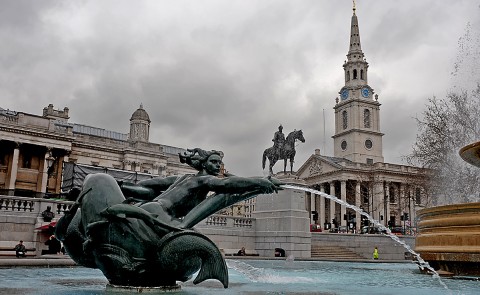When the best of times and the worst of times coincide
At St. Martin-in-the-Fields, we’re living through beautiful, nightmarish days.

The Netflix series The Crown works because its writers grasp a particular aspect of storytelling technique: the interplay of cosmic events with intimate tenderness. One memorable episode, set in 1956, charts Queen Elizabeth’s personal concern that her husband is having an affair with a ballerina. Her public attention focuses on the emerging Suez crisis, which itself combines international relations with a clandestine plot between France, Israel, and Britain. Meanwhile, Elizabeth’s anxieties about her marriage interplay with her sister Margaret’s traumatic search to land a suitable spouse. As the episode draws to a climax, Israeli forces begin their invasion while Elizabeth goes to see the ballerina perform. The effect is exquisite.
Hans Urs von Balthasar describes this effect in his sprawling Theo-Drama. The intimate level is lyric: it’s intense and passionate but also subjective and partial. The public level is epic: it’s objective and wide-ranging but also detached and a little impersonal. When they interweave, the story becomes truly dramatic.
Read our latest issue or browse back issues.
Consider the Passion narratives. On an epic level, Jesus is dealing with the cosmic forces of sin and death and with the powers of the day. On a lyric level, he’s immersed in the fragility of Peter, the perfidy of Judas, the passion of the woman who anoints him, and the faithfulness of Mary and John. The interplay of the two is what makes the scene so powerful.
I’ve never felt this power as much as in recent weeks. My church, St. Martin-in-the-Fields in London, is a complex organization. It has a large congregation, by UK standards, and a significant public ministry, involving a good deal of broadcasting on the BBC. It has a commercial subsidiary (two cafés, a shop, and about 200 concerts annually). It has a development trust and two homeless charities, one local and one national.
The pandemic has asphyxiated the commercial activity, at a stroke deleting two-thirds of the church’s income. Yet online, the congregation, its public ministry, and its music have found a new reach, purpose, and dynamism. The musicians have recorded music weekly for 4,000 churches across the land. Our HeartEdge seminars have become a hub for innovation and evaluation. A new enquirers’ course has drawn participation from people far and wide, many of whom were already inhibited by chronic illness before the pandemic. The national homeless charity has never been more in demand or attracted more support.
The combination of these events has led to days of almost unimaginable contrast. In July, all 125 employees of the business were told their roles were at risk of redundancy. Staff representatives have been describing their colleagues’ feelings and circumstances on frequent Zoom calls, as several of those same representatives have been told their own roles are likely to go. Some staff members have shrugged their shoulders and said, “I’ve seen the news and what’s happening to my friends. I knew it was coming.” Others have been totally blindsided that St. Martin’s could not somehow remain immune to the virus.
But the same day one of the most difficult conversations took place, I led the first BBC broadcast of choral evensong since March. That same evening I admitted 11 new members to our Nazareth Community, made up of people from all classes, including those who sleep outside, who are seeking the heart of God through shared practices centered on silent prayer. Founded two years ago, it has grown to 81 people with dozens of online companions. It models the way we seek to see the assets in everyone, rather than regarding some as needy and others as benefactors.
It’s as if we’re in a cartoon: on one side surrounded by footfall figures, government directives, church guidelines, protective equipment, and spreadsheets of redundancy calculations, earnestly trying to be humane, transparent, and compassionate as we cast staff out into a wilderness of high unemployment and health anxiety; on the other side surprised by joy, with people coming to faith, hundreds of thousands downloading choral offerings, asylum seekers stepping up to leadership roles, donors tendering generous gifts, and the church reopening for tentative public worship. In the background, intense discussions in which health and economics, the present and the future, caution and improvisation, hard-nosed fact and finger-in-the-air guesswork seem in impossible tension with one another.
Don’t tell anyone, but beautiful things are happening—too many to recount. Keep it quiet, but it’s also a complete nightmare, in which an institution and its plans are being torn apart in ways a raging inferno couldn’t achieve. There’ve been a few moments when I’ve realized, “I have no idea what to do or how this story can go on,” and the tears have been hard to suppress. And yet, like a ram in a thicket, something has been provided, or has emerged, or has suddenly changed.
“It was the best of times. It was the worst of times.” Charles Dickens’s summary of the French Revolution is a good fit for the pandemic at St. Martin’s. A child asked me, “Did God create coronavirus?” I answered, “I don’t believe so. But God made the ability to change. Biologists call it mutation. Some changes are really bad ones, like this virus. But human beings can change too. And to get out of this hole, it looks like we’re going to need to change a lot. Maybe for the better.” As always in ministry, the hardest thing is to take your own advice.
A version of this article appears in the print edition under the title “Beautiful, nightmarish days.”







